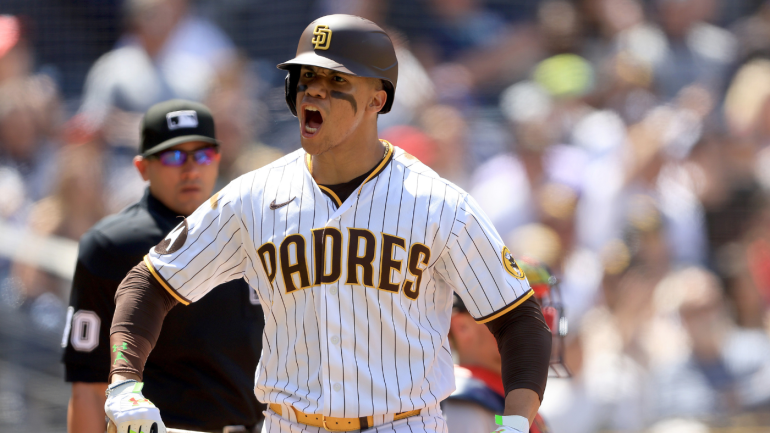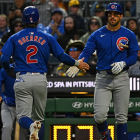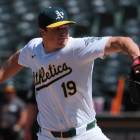
The San Diego Padres and San Francisco Giants will play two games in Mexico City this weekend in Major League Baseball's latest effort to grow the brand's international footprint. Sunday's contest will have additional significance for the Padres: it will mark Juan Soto's 81st game since joining San Diego as part of a blockbuster trade made last deadline with the Washington Nationals.
Soto, 24, was on a Hall of Fame track prior to the trade. In parts of five seasons in D.C., he hit .291/.427/.538 (160 OPS+) with 119 home runs. Things haven't been as sweet out west. Soto performed well overall with the Padres down the stretch last season (130 OPS+), but a slow start this year has raised eyebrows. Entering Saturday, Soto has batted just .183/.345/.344 (98 OPS+) with four home runs in his first 27 games. His career line with the Padres, in turn, is down to .218/.373/.375 (119 OPS+) with 10 home runs.
What, precisely, is going on with one of the sport's best hitters? Below, we've attempted to explain Soto's slow start through the use of three subheadings.
1. Still hitting ball hard
One of the best things a hitter can do is strike the ball with authority. It's not the only skill that matters, nor is it the only one that dictates performance. It is, nonetheless, an important trait that is often found in the best hitters.
From that perspective, there's reason to be encouraged by Soto's start to the year, even if his topline statistics suggest otherwise. Indeed, he enters Saturday with an average exit velocity of 91.9 mph. That's a full tick higher than last year, and about even with the 92.1 mark he posted in 2020, or the best effort of his career, as judged by OPS+. (He averaged 93 mph in 2021.)
That ball is Juan gone... very gone 🤯#BringTheGold pic.twitter.com/MDrlWnTcHm
— San Diego Padres (@Padres) April 19, 2023
Soto's average exit velocity is not being skewed by a few extremely hard hit balls, either. Some 55.7% of his batted balls this season have had exit velocities of 95 mph or hotter. He was under 50% in that same category last season, and his high mark since the start of the Pandemic Era is 52.8% from 2021.
Predictably, Soto ranks well league-wide in both respects. His average exit velocity is 29th among qualified batters, around the likes of Vinnie Pasquantino, Brandon Lowe, and Yordan Alvarez. His percentage of hard-hit balls, meanwhile, is 11th -- just ahead of Randy Arozarena and Ronald Acuña Jr. One thing you'll notice about all those names mentioned in this paragraph: unlike Soto, they're all sporting OPS+ this season that are north of 130.
2. Batted-ball profile has changed for the worse
As we mentioned above, hitting the ball hard is only part of the equation. The direction of those batted balls, in full three-dimensional terms, also matters. A batter who hits the ball hard straight into the air (or ground) will have less success on average than a batter who hits the ball on a line-drive trajectory.
Soto has always been an interesting case study in this respect since he's hit for power despite posting launch angles in the single digits. For example, take a look at how Soto stacks up to Yandy Díaz in some important categories. (We're using Díaz because he has served as a go-to example whenever people use exit velocity to determine which batters have unfulfilled slugging upside.)
| Batter ('20-23) | PA | EV | LA | HR | ISO |
|---|---|---|---|---|---|
Soto | 1,630 | 91.9 mph | 7.1 | 73 | .227 |
Díaz | 1,347 | 91.2 mph | 6.0 | 31 | .135 |
There's not much difference there until you look at the power-based statistics at the end. Why is that? There can be a variety of explanations, including the deviation in launch angles -- average is a useful measure, but two players can arrive at a similar average through different means; one fluctuating between extremes and the other steadily hitting the ball within a smaller range.
That's a useful concept to think about as it pertains to Soto because he does appear to be hitting the ball at the extreme ends more frequently this year. Take a look at his year-by-year breakdowns of batted balls struck between 10 and 30 degrees, as well as his "barrel" rate -- a shorthand way of seeing how often a batter is hitting the ball hard at an optimal launch angle:
| Season | 10-30% | Barrel% |
|---|---|---|
2019 | 31.7% | 27.8% |
2020 | 27.1% | 21.1% |
2021 | 25.5% | 21.3% |
2022 | 18.0% | 18.0% |
Soto's batted-ball profile has consistently drifted away from the 10-30 degree window. He's barreling up the ball less often, too. In turn, he's hitting the ball to the extreme sides of the spectrum more often. His 57.8% groundball rate would be the highest of his career, as would his 7.8% pop-up rate. The latter, and its slew of automatic outs, helps explain his deflated average.
Every batter has their own ideal batted-ball profile. We know that throughout Soto's career, he's done his most damage when he's hit the ball between 5 and 35 degrees. Conversely, he's done the least amount of damage when he's hitting the ball higher than 45 degrees. Remember that as you look at his three most populated launch-angle bins so far this year:
-5 to 5 degrees: 12 batted balls
-15 to -5 degrees: 10 batted balls
45+ degrees: 9 batted balls
Sure enough, our above deduction was correct: Soto is making loud contact, but a lot of it is flying in extreme directions that are unlikely to yield great results: right into the ground, or right into the air.
Why's that? We're not swing experts, but there are a few possible explanations, including his point of contact and his swing plane. Keep that in mind as we transition to our final subheading.
3. Pulling more, whiffing more
We've established that Soto's problem -- making contact to undesirable areas -- may have to do with his point of contact or his swing plane. It may not come as a surprise, then, to learn that Soto is trending in what appears to be the wrong direction in some related areas: pull and whiff rates.
Soto entered this season with a career pull rate of 28.8%. So far in 2023, he's pulled more than 42% of his balls to right field. What's more is that he's coming up empty far more often than usual. His 73.3% contact rate this season would qualify as the first time he's ever finished below 75%, and it would represent the first time since 2020 that he connected less than 80% of the time. (And, bear in mind, his contact rate that season was 78.6%.)
Juan Soto has struck out 21 times in his last 15 games. He's never struck out more often in any 15-game span of his MLB career. pic.twitter.com/X98TUJtg72
— Codify (@CodifyBaseball) April 27, 2023
Soto remains disciplined, in terms of separating balls from strikes, and he's actually swinging at what would be the lowest rate of his career. His longstanding willingness to work deep counts, plus his newfound contact woes, help to explain why he's striking out at an uncharacteristic clip. Factor in his aforementioned quality-of-contact issues, and you can understand why he's scuffling to begin the season relative to his established track record.
What does all of this mean for Soto going forward? We think it's clear that he remains a highly skilled batter based on his exquisite eye and his feel for making loud contact. The rest of the profile hints at an underlying philosophical change -- perhaps he's in his head about justifying the trade, or, maybe he wants to maximize his power numbers ahead of his winter 2024 date with free agency. Maybe it's neither and these changes weren't by design.
Whatever the inspiration, the emphasis for Soto should be examining his point of contact and his swing plane and making the necessary adjustments. That's easier said than done, especially for a player under an unforgiving microscope, but that appears to be the key for getting Soto back on his once-glorious track.






















